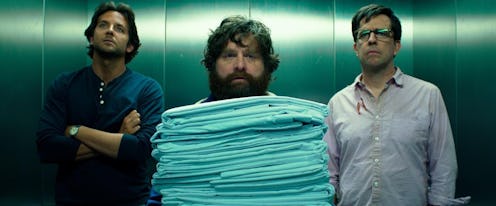Entertainment
How Did LGBT People Fare in 2013's Movies?

Last August, I wrote an article discussing the results of the first annual GLAAD "Studio Responsibility Index" study, which revealed the disastrous state of both the amount of LGBT characters depicted in the movies and the quality of their representation. On Tuesday, GLAAD released their 2014 study, and unfortunately, their findings are not much more encouraging than last year's — in fact, many of them are even worse.
According to the organization's website, the 2014 Studio Responsibility Index (SRI) "maps the quantity, quality and diversity of lesbian, gay, bisexual and transgender (LGBT) people in films released by seven major motion picture studios during the 2013 calendar year" in order to help bring attention to and make progress regarding the depiction of LGBT characters in film. Last year's study focused on 101 films released by the major studios and found that only 14 of them contained LGBT characters; this year's studied 102 films, and learned that LGBT characters appeared in only 17, a figure that translates to a paltry 16.7 percent. Even worse, only seven of those movies passed the "Vito Russo Test," a Bechdel-like quiz meant to determine the significance of an LGBT character's inclusion in a movie.
The entire study is absolutely worth reading, as it's guaranteed to open your eyes to the inexcusably bad state of LGBT representation in film. Hollywood has always been behind the curve when it comes to featuring diversity, but TV, at least, is making significant progress; movies, on the other hand, seem to be moving backwards, relying on outdated stereotypes and derogatory nicknames instead of making strides towards inclusion. The GLAAD study is disturbing and enlightening, and hopefully, studios will take a good look at this year's findings before greenlighting yet another gay joke or cliched character. Or, better yet, they'll actually consider making a movie with an LGBT character in the lead; of all the 2013 releases, not a single one had a non-straight character in the starring role.
Six other startling takeaways from the study:
The Most Inclusive Major Film of 2013 Was a YA Flop
Not many people saw The Mortal Instruments: City of Bones, but if they had, they would've learned that it was perhaps the most LGBT-friendly major studio film of last year. Featuring two complex, important LGBT characters, the movie defied expectations and helped Sony Colombia see their rating changed from "adequate" to "good."
Indie Studios Do Better Than the Big Ones, But Not By Much
GLAAD's study only focused on the seven major studios – Sony Columbia, 20th Century Fox, Walt Disney, Paramount, Universal, Warner Bros., Lionsgate — without taking the films released by smaller companies into account, because the latter's films are typically distributed to smaller, niche markets, not general audiences. If they had, though, the study would've included LGBT-friendly films like Kill Your Darlings, Blue is the Warmest Color, and Dallas Buyers Club. Even those numbers, though, could certainly be increased.
Gay Men Are The Most Represented Group
Of the LGBT characters featured in 2013 films, gay males made up a whopping 64.7%. Lesbians were represented in 23.5% of movies, bisexuals in 17.7%, and transgender women in 11.8% — although the quality of the last group's representation was by far the worst; of the two movies featuring transgender women, one character was shown as a prison inmate and the other was only there as amusement for the straight leads.
Even in LGBT-Friendly Movies, Diversity is Low
The study found a disproportionate number — 76% — of white LGBT film characters. Black characters, meanwhile, made up just 12%, and Asians and Latinos fared even worse, with 8% and 1%, respectively.
Paramount and Warner Bros. Need to Do Better
Paramount and Warner Bros. were the only studios this year to receive a "failing" rating, and for good reason; of the two films Paramount released featuring LGBT characters, both movies showed them getting beaten up. Even worse, neither of the violent attacks were crucial to either movie's plot. As for Warner Bros., We're the Millers (above) featured plenty of homophobia, and The Hangover Part III, like the first two films in the franchise, continued to turn the character Leslie Chow into a gay cliche.
Lionsgate, Though, is Making Progress
For the first time, GLAAD included Lionsgate in the study, thanks to the studio's recent rise in influence. Although the company only received an "adequate" rating for the three LGBT-inclusive movies it released in 2013, one of them was Peeples, which depicted a lesbian daughter's concern over coming out to her family. Another was Instructions Not Included, in which a lesbian couple fight for custody of a child, although the movie did contain some extremely offensive transgender jokes. Still: it's progress, hopefully the beginning of much more to come in the years to follow.
Image: Warner Bros. (2); Sony Columbia; 20th Century Fox